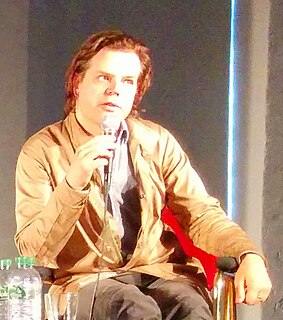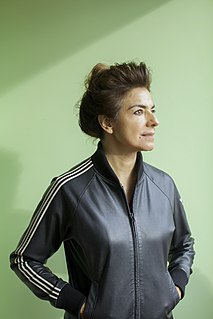
COBRA was a European avant-garde movement active from 1948 to 1951. The name was coined in 1948 by Christian Dotremont from the initials of the members' home countries capital cities: Copenhagen (Co), Brussels (Br), Amsterdam (A).

The Stedelijk Museum Amsterdam, colloquially known as the Stedelijk, is a museum for modern art, contemporary art, and design located in Amsterdam, Netherlands.

Art & Project was a leading contemporary art gallery by Geert van Beijeren & Adriaan van Ravesteijn from 1968 to 2001 in Amsterdam and Slootdorp, the Netherlands, as well as an influential art magazine published by the gallery between 1968 and 1989.
Gabriel Lester is an inventor, visual artist and film director living and working in Amsterdam. His practice encompasses music, cinema, spatial installation, performance art, sculpture, architecture, photography and prose.
Petra Blaisse is a British-born Dutch designer. Her work is an intersection of the professions of architecture, interior architecture, landscape architecture, textile design, and exhibition design.

Miguel-Ángel Cárdenas, also known as Michel Cardena, was a Colombian-Dutch, New Realism and Pop Art painter and a pioneer of video art in the Netherlands. His works cover a variety of artistic media, including painting, drawing, video, photography, object assemblages and digital art.

Renzo Martens is a Dutch artist who currently lives and works in Amsterdam and Kinshasa. Martens became known for his provocations, including Episode III: Enjoy Poverty (2008), a documentary that suggests that the Congo market their poverty as a natural resource. In 2010 Renzo Martens initiated the Institute for Human Activities (IHA) that postulates a gentrification program on a palm oil plantation in the Congolese rainforest.

Nan Hoover was a Dutch/American-expatriate artist who is known for her pioneering work in video art, photography and performance art. She spent almost four decades living and working in the Netherlands. She also used the mediums of drawing, painting, photography and film and created art objects and sculptures. One of the main themes of her art was light and motion. The rigorous, minimalist handling of her means as well as the intense concentration with which she performed within spaces of light and shadow are the most salient characteristics of her artistic work.

Alicia Framis is a contemporary artist living and working in Amsterdam, Netherlands. She develops platforms for creative social interaction, often through interdisciplinary collaboration with other artists and specialists across various fields. Her work is project based and focuses on different aspects of human existence within contemporary urban society. Framis often starts out from actual social dilemmas to develop novel settings and proposed solutions. Framis studied with the French minimalist artist Daniel Buren and the American conceptual artist Dan Graham and her work can be located within the lineages of relational aesthetics, performance art, and social practice art. She represented the Netherlands in the Dutch Pavilion at the 50th Venice Biennale (2003). She is currently the director of an MA program at the Sandberg Instituut in Amsterdam, Netherlands and a lecturer at Nebrija University in Madrid, Spain. In 2019, Alicia Framis was awarded with the Lucas Artists Visual Arts Fellowship 2019-2022 in California.
Project 1975 started in 2010 as a two-year project based in the Netherlands with the intent to explore the relationships between contemporary art and postcolonialism. Through this project Stedelijk Museum Bureau Amsterdam (SMBA) explored the role of art and visual culture in the context of colonial practices. The project consisted of multiple exhibitions, seminars, reading groups, articles, and a blog. "1975" in the title refers to the year that Suriname gained independence and the Netherlands thus became to some extent "postcolonial".

The Marx Lounge is an art exhibition by the Chilean artist Alfredo Jaar. It was first presented at the Liverpool Biennial art exhibition in England in 2010 and was later shown at the Biennial again in 2016. The exhibit has subsequently been presented at the Stedelijk Museum Amsterdam's SMBA space and the Andalusian Center for Contemporary Art (CAAC). For the exhibition a large space was transformed into a red reading room with sofas, reading lamps and a large reading table on which a large collection of books was installed.
Hendrik Krawen is a contemporary visual artist and installation artist.
Chris Evans is a British artist based in London and a tutor at De Ateliers in Amsterdam. He was the bassist for the now defunct band Life Without Buildings.
Melanie Bonajo(she/they/mel/creature) is a queer Dutch artist working with film, performance, installations, music, event organizing, and photography. Her works address themes of eroding intimacy and isolation in an increasingly sterile, technological world. Their experimental documentaries often explore communities living or working on the margins of society, either through illegal means or cultural exclusion. In addition to their art practice, Bonajo is a certified Sexological Bodyworker, Somatic Sex Coach and Educator, International Cuddle Workshop Facilitator, and animal activist. Creature's work has been exhibited and screened internationally, from the Tate Modern, MoMA PS1, to De Appel Arts Centre and Stedelijk Museum in Amsterdam to Manifesta 12, the Gwanjou Biennale, the Center for Contemporary Art, Warsaw, the Kunsthalle Basel, International Documentary Film Festival Amsterdam (IDFA), the Berlinale, the International Film Festival Rotterdam, and Treefort Film Fest.
Dina Danish is a French-born Egyptian artist who lives and works in Amsterdam
Nubuke Foundation is an art foundation in East Legon in the Greater Accra Region of Ghana. It was established in April 2006.

Bernard Akoi-Jackson is a Ghanaian academic, artist and writer. He is known for projects that are in continual metamorphosis. His art works are mostly performative or pseudo-rituals. His writings are focused on the development of contemporary African, Ghanaian visual arts and culture in poetic and jovial manner. He is known as a proverbial jester or Esu using critical absurdity to move between installations, dance and poetry, video, and photography. He blends post-colonial African identities through transient and makeshift memorials.

Melvin Moti is a Dutch contemporary video and media artist who examines neurological, scientific and historic processes in relation to visual culture. His work explores ideas of human experiences of spirituality, space, time and consciousness.
Krist Gruijthuijsen is a curator and art critic, and since July 2016, Director of KW Institute for Contemporary Art in Berlin, Germany. At KW, he has curated exhibitions with, among others, Hanne Lippard, Ian Wilson, Adam Pendleton, Ronald Jones, Hiwa K, Willem de Rooij, Beatriz González, David Wojnarowicz, Hreinn Friðfinnsson, and Hassan Sharif.









